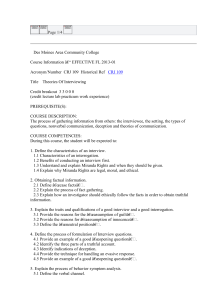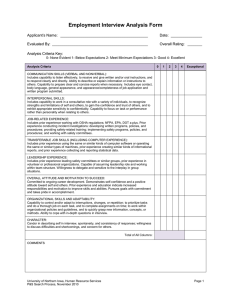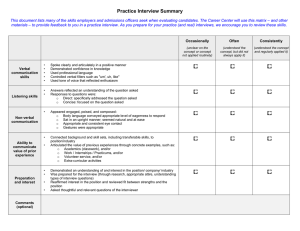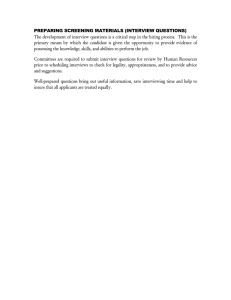Criminal Investigation Interview Process Part 8
advertisement
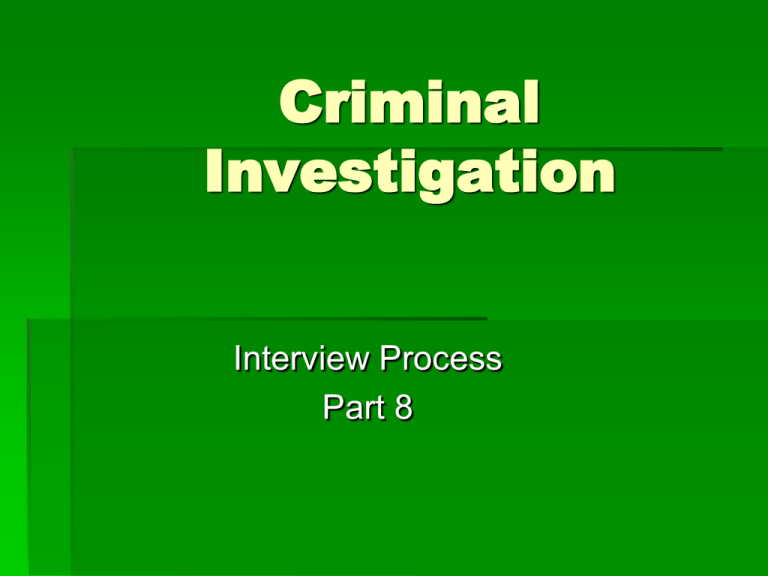
Criminal Investigation Interview Process Part 8 Interview Process 1. Interview application - questioning people - cooperative a. Purpose - obtain knowledge - interview / physical evidence - most cases rely on both b. Goal Interview, cont. - identify those responsible - eliminate the innocent c. Information received: - prove elements - provide leads 2. Three primary sources: a. People - complainant: reported crime / incident Interview, cont. - witness: some information - victim: person injured - informant: personal benefit / desire - suspect: can be / cooperative b. Physical evidence - suspect items on victim - victim items on suspect - suspect items at scene Interview, cont. c. Reports / records - information source - police records - other records 3. Preparation - establish rapport - maintain privacy - psychological advantage - quiet interview room Preparation, cont. a. Verbal behavior analysis - listen - not just what / but how - timing / rate / pitch / clarity - truthful attitude vs. deceptive attitude b. Truthful - spontaneous - helpful - concerned - sincere Preparation, cont. c. Deceptive - guarded - unhelpful - unconcerned - insincere (1) Truthful - sincere / direct / spontaneous / no delay / realistic words / consistent / no qualifications Preparation, cont. (2) Deceptive - delay response / evasive / rapid pace / talk unclearly / change pitch / levity or nervous laughter / bolster answers / sophisticated 4. Witness interview - interview separately - victim / complainant - eyewitnesses - others Preparation, cont. a. Time / place - may not have opportunity b. Identify - keep separate - confidential - not used / unless court c. Reactions - may forget - change story Beginning Interview 5. How starts / very important a. Size each other up - police: understand witness - witness: holding back b. Establish barriers - our own space - officer encroachment - officer attitude Beginning, cont. c. Friendly / professional - smile / apologize - identify / identification d. Rapport - friend - not adversary - understanding - non-judgmental - good listener Interview Techniques 6. Location - interview room - home of witness - not at workplace a. Small talk - put at ease - safe / comfortable b. Reciprocity Techniques, cont. - exchange of information - part of investigation c. Deception - be truthful - only when necessary d. Listen / empathize - show concern - there to help Techniques, cont. e. Help recall events - do not suggest answers - guide answers f. Choose questions - keep short - confined g. Point out conflicts - statements from others - not change mind / influence Techniques, cont. h. Be observant - signs of lying - initial statement i. Body language - be conscious of 7. Interview Guidelines a. One question - do not confuse Guidelines, cont. - no multiple questions b. Responses simple / direct - do not ramble - or compare c. Avoid “yes” or “no” questions - narrative - reveal inconsistencies d. Positive approach Guidelines, cont. e. Be positive - let “save face” f. Time to answer - ask - not demanding g. Listen - understand - repeat if necessary - prepare from response Guidelines, cont. h. Body language / tone of voice - anger or offend - want cooperation i. Neutral territory - how they feel - you know j. Caution recording - agree - pertinent information Guidelines, cont. k. React - notes / head nod / verbal inclinations - important l. Professional distance - no personal involvement 8. Direct / indirect questions - two types to ask a. Direct Guidelines, cont. - to the point b. Indirect - skirts the issue 9. Two sources of information a. Investigative - witness saw / heard - establish alibi - validity of statements made Information, cont. b. Behavioral - posture / attitude - hand / leg movements - eye contact - way statements made (1) Person telling truth - fear of detection (2) Innocent person fears - not believed Information, cont. - retribution - loss of esteem c. Privacy - important element - exists in the mind (1) Isolation best - not necessary - no time / location Information, cont. (2) Separate on street - back to back (3) Demeanor - talk softly - reassure confidentiality (4) Officer appearance - interested - approachable - non-judgmental Body Language 1. When questions asked a. Barriers - folded arms / crossed or extended legs - timing important - incriminating questions b. Protective gestures - elbow on desk - hand on chin / over mouth - hide eyes Language, cont. c. Grooming gestures - picking lent - smooth hair - straighten tie 2. Non-verbal illustrations a. Untruthful - use hands to illustrate - clarify / recreate activity - truthful don’t use Language, cont. b. Deceptive posture - non-frontal - hand on chin / arms crossed - rigid / retracted feet - sitting on hands - slouched / feet extended - position unchanging - static c. Eye contact - 30 % to 60 % Language, cont. (1) Truthful - mutual gaze - direct eye contact (1) Deceptive - incriminating questions - look away 3. Evaluate attitude a. Truthful person Attitude, cont. - anxious to resolve - freely discuss (suspicions / theories / and speculations) b. Deceptive person - reluctant (1) No crime occurred - making up story - self-committed (suicide) - money will turn up Attitude, cont. (2) Volunteer nothing - careful thought / words used - overly friendly / polite b. Evaluate responses - attempt to avoid anxiety - avoidance means: verbal / nonverbal c. Four possible responses - truth / omission / evasion / denial Attitude, cont. - example: “Did you steal the $5000.00?” (1) Truth: “Yes, I did.” (2) Omission: No verbal response (3) Evasion: “Why would I do that? I like my job too much.” (4) Denial: “No, I did not.” Attitude, cont. 4. Anxiety - omission / evasion = than denial a. Evasive answer: “Did you shoot the victim?” - “I was home all day.” - “I don’t even own a gun.” b. Speak in irrational manner - fragmented / incomplete sentences - “It’s important that . . . , if you think . . . , I hope that you . . . .” Attitude, cont. c. Feign memory failure / half-lie - “I don’t remember.” - “As far as I know.” - “I don’t recall.” d. Bolster answer - “To be perfectly honest with you, . . . .” - “To be quite frank, . . . .” e. Sophisticated answer - they have thought about their answer Attitude, cont. - “At this point in time, . . . .” - “I may be mistaken, but . . . .” f. Use of religion - “I swear to God.” - “As God is my witness.” - “I swear on a stack of bibles.” 5. Nonverbal responses / behavior - body movement / position change / gestures / facial expressions / eye contact Nonverbal, cont. - communication level: more than ½ nonverbal a. Verbal statements - carefully thought out - conscious control b. Do not pay attention - physical movements / gestures - more than ½ of meaning c. Examples: Nonverbal, cont. (1) Suspect: “Did you commit the robbery?” - Firm voice: “Absolutely not, I had nothing to do with it.” - leans forward / open posture / maintain eye contact - shows sincerity / directness (2) Suspect 2: same question - weak voice: “No, I . . . , it wasn’t . . . , I didn’t do it.” - shifts position / cross arms / look away - shows deception Nonverbal, cont. d. Posture / attitude - forms foundation (1) Evaluating posture - reflects: emotions / interest level / confidence (2) Truthful person - high interest / emotionally involved / expresses confidence Nonverbal, cont. (3) Deceptive person - emotionally withdrawn - preoccupied - less interest - lacks confidence 6. Time considerations - most fundamental concept - indicators of deception a. Occurs in 4 stages Time, cont. - during questions / response (1) First stage - asking of questions by investigator - person interpreting contents - obvious threat to them - form verbal response (2) Second stage - “response latency” - last word question / first word response Time, cont. (3) Third stage - subject responding to question (4) Fourth stage - post response period - completes verbal response - still exhibits nonverbal indicators (a) Relief interview is over (b) Concern whether believed or not Time, cont. b. Factors affecting nonverbal behavior - individual’s personality (1) Level of socialization - educational - interaction with others - people interact with (2) Motivation - what is right - unfriendly witness Time, cont. - want to get suspect arrested (3) Psychological problems - mentally incompetent (4) Physiological problems - alcoholic / drug addict (5) Emotional state - family member killed - accomplice killed by police Time, cont. c. Behavioral analysis - valid / reliable means - not 100% (1) Evaluate behavior - findings not support guilt - view with caution (2) Exhibit truthful indicators - findings show guilt - pathological liar
